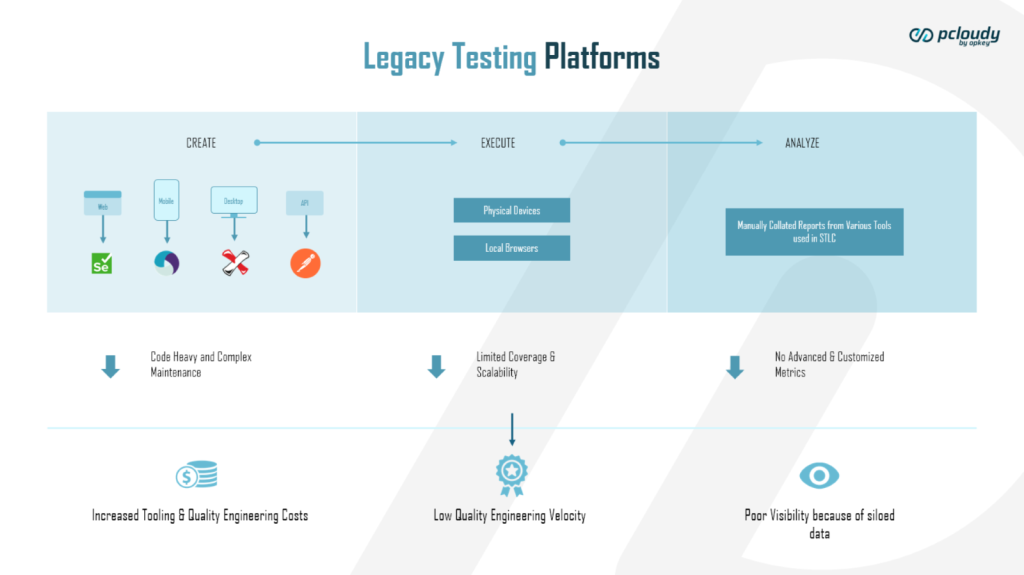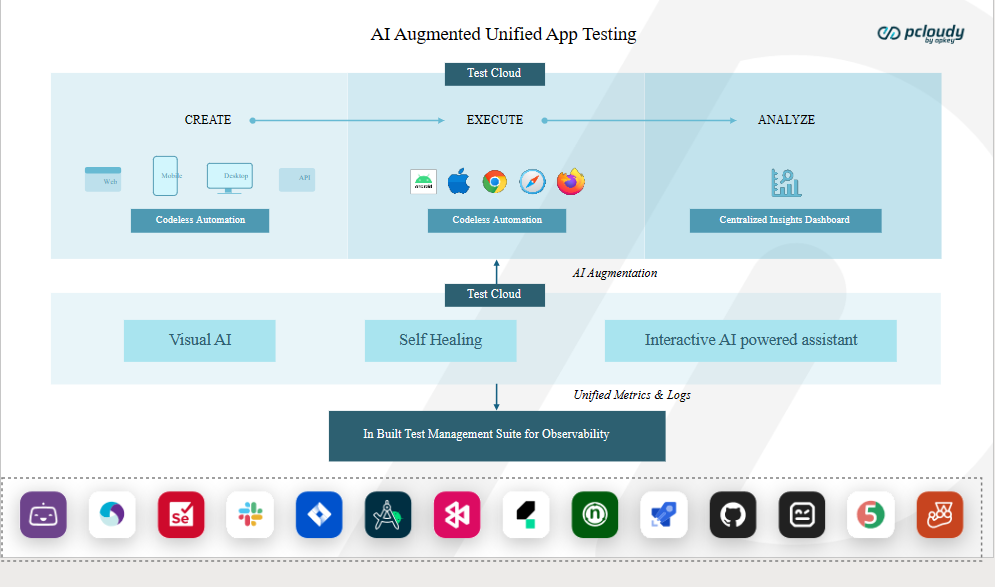In the ever-evolving realm of digital transformation, the urgency for digital leaders to embrace modernization has never been more pressing. According to Forrester, a staggering 69% of organizations consider legacy application modernization a top business priority.
Moreover, another Forrester study has unveiled that upgrading legacy applications can amplify the productivity of your development team by as much as 40%.
These statistics underscore the critical importance of modernizing testing methodologies to keep pace with the rapidly evolving digital landscape. Legacy applications, often constructed on outdated or unsupported technologies, pose significant barriers to innovation and scalability. As organizations navigate the complexities of digital transformation, the need to overhaul legacy testing practices becomes increasingly apparent.
The Legacy App Testing Dilemma: A Barrier to Innovation
For decades, legacy app testing practices have plagued enterprises with inefficiency, complexity, and spiraling costs. Siloed processes, disparate tools, and manual interventions impede progress, leading to prolonged release cycles and compromised quality. The burden of technical debt looms large, stifling innovation and eroding competitiveness in an unforgiving market landscape.
Consider the case of Shopify. In 2019, the development team at Shopify made the decision to overhaul their outdated application system, which stands as one of the largest Ruby on Rails codebases. Kirsten Westeinde, a member of the engineering team, elaborated on the situation, stating, “Initially, it was constructed as a monolith, meaning that all distinct functionalities were integrated into the same codebase without clear boundaries between them. While this architecture served us well for many years, we eventually reached a juncture where the drawbacks of the monolith began to outweigh its benefits.”
Several challenges arose from the legacy application:
- Growing difficulty in building and testing new features.
- Testing on increasingly fragmented device and browser sets
- Fragile code leading to unexpected and frequent failures.
- Complications in onboarding new developers.
To address these issues, the team opted for a modular monolith approach and unified their Tech stack to achieve scale.
There have been several stories like Blockbuster, Nokia, Kodak who failed because they failed to understand the importance of staying ahead with the trends.
Infact, legacy applications, often pose significant barriers to innovation and scalability. These systems hinder organizations in various ways:
- Compliance issues: According to a 2023 report by KPMG, 72% of organizations struggle with compliance challenges stemming from legacy apps.
- Reduced employee productivity: Research from McKinsey in 2023 highlighted that legacy apps impose an additional 20-30% time burden on tasks, diminishing overall productivity.
- Lost customers: A study by Microsoft in 2023 underscored the alarming statistic that 91% of customers discontinue business with companies hindered by antiquated technology.
These stark realities paint a clear picture of the detrimental impact that legacy testing methodologies can have on organizations. As the digital landscape evolves rapidly, enterprises must adapt or risk falling behind.
Fast forward to today, many organizations still continue to rely on manual testing procedures and outdated automation tools characterized by heavy reliance on code. This poses several challenges, including high resource consumption, maintenance complexities, and long-term sustainability issues.
Moreover, the execution of automation scripts often occurs on local browsers and physical devices confined to specific locations. This localized approach to testing restricts collaboration between global teams spread across different geographical regions. Coordinating testing efforts, particularly across diverse time zones, becomes cumbersome and hampers the velocity of app releases.
Additionally, organizations grapple with the lack of visibility into the status of ongoing tests. Bug tracking and defect analysis are often conducted in isolation, leading to fragmented information dissemination. Program managers and scrum masters rely on disparate reports, resulting in potential human errors and delayed insights into the current testing cycle. This fragmented process complicates decision-making and prolongs the release timeline.

Unification of app testing process and tools and adopting AI is the way ahead and its a wake upcall for digital leaders to understand the need for it.
Embracing a Unified Testing Paradigm: The Blueprint for Success
The time for change is now. Enterprises must embrace a unified approach to app testing, one that harmonizes automation, device cloud technology, and streamlined maintenance into a cohesive framework. By breaking down silos and fostering collaboration across teams, organizations can unlock a myriad of benefits that directly impact app delivery time, costs, efficiency, and overall agility.
How to Achieve Testing Excellence: A Roadmap for Success
- Embrace Unified Testing Methodologies: Consolidate your testing processes for streamlined efficiency and agility.
- Harness the Power of AI-Driven Automation: Let artificial intelligence supercharge your testing efforts for unparalleled speed and accuracy.
- Leverage Device Cloud Technology: Access a diverse array of devices for comprehensive testing coverage, ensuring optimal performance across platforms.
- Prioritize Test Maintenance Integration: Streamline your testing infrastructure for seamless maintenance and scalability.
- Invest in Team Empowerment: Equip your QA professionals with the tools and resources they need to succeed in the digital age.

The Data Speaks: A Case for Modernization
According to recent data from Gartner, organizations that adopted unified testing methodologies experienced up to a 30% reduction in app delivery time. Furthermore, insights from the World Quality Report highlight that enterprises leveraging AI-driven automation witnessed a significant decrease in total cost of ownership, paving the way for enhanced competitiveness and innovation.
Additionally, let’s explore how AI-driven enterprises are leading the charge in modernization efforts:
- Data-Driven Decision Making: AI-driven enterprises leverage data analytics and machine learning algorithms to identify inefficiencies and bottlenecks in their testing processes. By analyzing vast amounts of data, these organizations gain valuable insights into testing trends, performance metrics, and areas for improvement.
- Continuous Improvement: With AI-driven testing solutions, enterprises can achieve continuous improvement in their testing practices. By automating repetitive tasks, detecting anomalies, and predicting potential issues, AI enables organizations to enhance the quality and reliability of their apps while reducing time-to-market.
- Competitive Advantage: In today’s fast-paced digital landscape, agility is key to maintaining a competitive edge. AI-driven enterprises leverage modern testing methodologies to accelerate app delivery, respond quickly to market changes, and stay ahead of the competition.
Unlocking Testing Excellence with pCloudy
Enter pCloudy, an AI augmented Unified app testing platform, poised to revolutionize your testing journey by bringing No code test automation, a comprehensive device cloud and test management together in a single platform. It has helped a leading American healthcare company, a global enterprise grappling with legacy testing challenges. By leveraging pCloudy’s platform, the healthcare company streamlined their testing processes, increased their test coverage by 80% through codeless test automation and running the tests on 5000+ device browsers over cloud, and saved 350k$ worth testing costs.
With features such as AI-powered automation, comprehensive device coverage, and seamless integration capabilities, pCloudy empowers enterprises to achieve testing excellence in the digital age. It’s time to unlock the full potential of your app testing strategy with pCloudy.
Charting the Course for Testing Excellence
In conclusion, the journey to testing excellence requires a bold commitment to innovation and transformation. By breaking free from the constraints of legacy methodologies and embracing a unified testing paradigm, enterprises can unlock new levels of efficiency, agility, and competitiveness in the digital age.
The path ahead may be challenging, but the rewards are boundless. It’s time to seize the opportunity and embark on a transformative journey towards app testing excellence. Together, let us redefine the future of testing and drive unparalleled success in the digital era.


 April 04, 2025
April 04, 2025





